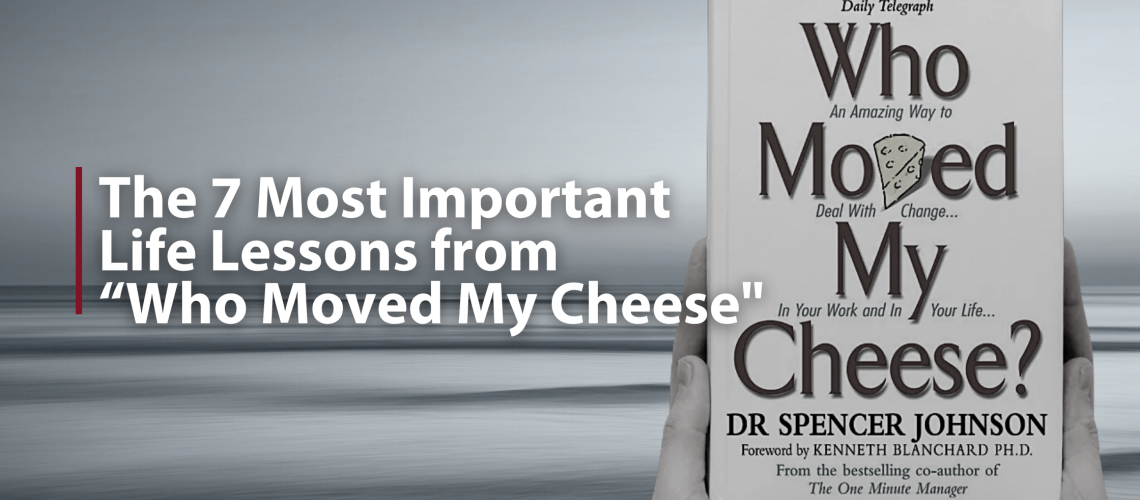
Amusing. Enlightening, Life-changing. That’s how I define ‘Who Moved My Cheese?’ by best-selling author Spencer Johnson. it is an amusing and informative parable story that has made me reflect on my life and business.
Every now and then, a business book comes along that talks about how the world views an area of focus. One of these is the book the 1999 best selling “ Who Moved My Cheese”. This short fable is illustrated like a children’s story and has some very interesting ideas about how businesses can approach the marketplace.
The book has helped many people who have lost their jobs view their future by providing them with a way to identify their new position. The message of this story can also be applied to various life transactions.
The message of the book
Who Moved My Cheese? is a book that explores how to deal with change, and how to embrace it. It’s a simple story about two mice (Sniff and Scurry) and two little people (Hem and Haw) who live in a maze. The maze has three rooms, where they find cheese, and the cheese never runs out. One day, the cheese suddenly disappears from one of their rooms. They go through all kinds of emotions—fear, anger, confusion—and they look for the cheese everywhere they can think of. Finally they meet the one who moved their cheese: a mouse who lives in another part of the maze!
the story Tells a fable you may use to your life to quit dreading the future and thrive in change and uncertainty.
Spencer Johnson’s cheese chunks represent what you desire in life: a nice career, a loving relationship, money, goods, health, or spiritual peace of mind. The maze is your workplace, family, or neighborhood. Cheese doesn’t stay forever. We may all find ourselves cheeseless if life changes and cheese supplies run out.
Sniff, Scurry, Hem, and Haw’s stories show how to handle change. Who Moved My Cheese? is deceptively easy (the sooner you let go of old cheese, the better; put on your running shoes and start looking). captures and explores significant and relevant life truths.
The message of this book is that life won’t always give you what you want when you want it; sometimes things change unexpectedly. But if we can find ways to adapt and overcome our fears, then good things will come around again for us.
Lessons Learned
The lessons that the book provides is that businesses can adapt to the changes that are happening in the market. They can also make the necessary changes to maintain their competitive advantage. The businesses that have learned how to manage change are the ones that will continue to be successful for a long time.
The grocery industry for example has seen a significant change in the past couple of years. Many of the major grocery stores went bankrupt as they waited for the cheese to return to the old way of buying from an ordinary grocery store. . However, some of these stores were able to adapt to the new business environment by developing new strategies and finding new niches in the market.
Other industries that have experienced significant changes such as the record industry, personal camera’s Industries and the book industry have also been forced to adapt to the changes brought about by the internet sales.
Here are some of the major Lessons Learned from the Book:
Lesson #1Be prepared for change.
The world is changing, and you need to be prepared for it.
If you’re in your mid-twenties, you’ve seen more change than any other generation in history—more than Gen Xers, more than baby boomers. You’ve been through the Great Recession, the tech revolution, and the rise of social media.
You know that change can come at any moment: a new technology, a new trend, a new economy… or even just a new boss. And when change happens, it can feel like everything around you is falling apart—and that’s something most people aren’t ready for.
Whether it’s a change in your workplace or your home life, take the time to notice the signs of change in your environment. For instance, you can develop a plan to handle the changes by learning new skills. In the Who moved my Cheese story, Scurry and Mice Sniff noticed that the cheese stockpile was getting old and dwindling. They then prepared to look for a new supply by stocking up on running shoes.
Lesson #2 move on Let go of the past
When things change, move on. The longer you wait, the harder it will be to adapt to the new situation.
Think of it like this: when you go to a new city, do you stay in your hotel room and try to deal with all the feelings that come from being in a strange place? Or do you get out there and explore? If you’re like most people, you want to get out there and explore; after all, that’s what getting up and going somewhere new is all about—learning something new!
When something changes in your life—like losing your job or moving away from friends—you have two choices: stay stuck in your old ways or adapt to the new situation. If you choose the latter, then it will be easier for you to adjust.
Lesson #3 Adapt—Be open-minded to new things
Being open-minded, having an open mind and a willingness to learn are all important factors that people can consider when it comes to adapting to new situations.
It’s easy to see how this would be important in the workplace. When you’re working for a company, you want to be able to work well with other people. In order for that relationship to work well, both sides need to be willing to listen to each other and keep an open mind.
If you’re working on a project with someone else, it’s important that both of you are willing to listen to one another’s ideas and suggestions without getting defensive or shutting down because they’re not what you expected them too be.
In order for your team members or co-workers at work feel comfortable coming up with suggestions or ideas, they need some space from what they’re used too—which might mean getting rid of some old habits or routines that no longer serve them well.
Imagine you’re in a new city and you want to try out the local cuisine. You might go into the restaurant with an idea of what you want—but it’s unlikely that the menu will have exactly what you’re looking for. Instead, you have to be open-minded about what they do have, and decide if it’s something you’d like or not.
Lesson #4 Imagine success
You know what success looks like. You’ve dreamt it, you’ve imagined it, and now you can feel it in your bones. It’s time to take the next step—it’s time to make that dream a reality.
Sometimes, when we’re facing challenges, our mind is too busy with all of the “what ifs” and “how on earth will I ever do this”‘s to allow us to move forward. We start thinking about what could go wrong instead of focusing on what we can do right.
But there’s a way around that! Visualizing success can help you feel better about yourself and set the stage for actually accomplishing your goals. In fact, research shows that visualization techniques can even improve athletic performance!
Once you’ve visualized what success would look like for you—whether professionally or personally—the next step is simple: Follow through on it!
Lesson #5 Handle your fears
Fear can also have two effects: It can either scare you away or motivate you to act. The former can cause you to act immediately if you are afraid that something will get worse if you don’t take action. The second is beneficial as it can help you feel better about yourself and make you more productive.
Fear can come in many different forms. We fear failure, rejection, being alone, and even success. But whatever the fear is, it’s important to remember that it’s only a feeling.
The best way to overcome this feeling is to face it head-on. If you’re afraid of failure, ask yourself what would happen if you failed? Nothing! You’d be right where you started. Or if your fear is rejection, ask yourself what would happen if someone didn’t like your work? They wouldn’t tell anyone else about it—you’d still have the opportunity to try again with someone else. And so on!
It’s important not to let your fears stop you from taking action. After all, if you never try anything new then how will you ever know what works?
So next time something scares you, remember: You are stronger than your fears!
Fear was the main reason why Haw didn’t want to go out into the maze and find new cheese. He also realized that he wouldn’t find any if he stayed put. He asked himself, “What would you do if you weren’t afraid?”
Lesson #6 Learning to enjoy change
In this modern world, change is the only constant. Learning to enjoy change is a very important skill for people to develop. It allows them to make new discoveries and achievements in their lives It also helps them feel more fulfilled and motivated, which is something that we all need to experience at least once in our lives.
We have all been through the process of change several times in our lives. We have changed schools, jobs, friends and even our appearance. But we do not always enjoy this process because it can be difficult and stressful at times.
When you learn how to embrace change, though, it opens up doors that were previously closed off—and these doors are filled with opportunities for growth and fun!
Lesson #7 Be prepared for continuous change
You will be surprised at how quickly things change. And when they do, you need to be ready to adapt and learn. If you don’t, then you will miss opportunities. You will be left behind, and your life will become stale.
The world is changing faster than ever.
In fact, the rate of change is so rapid that it’s hard to keep up.
It’s not just about technology (though that’s certainly a big factor). It’s about how people interact with each other and their environment.
One day you’re making a phone call; the next day, you’re texting with your friend who moved across the country—and they’re right there in front of you! It’s like magic! And then, suddenly, your phone calls have been replaced by video calls… which are even better!
You can’t help but notice all these changes—and they’re happening so fast. But what if I told you that there’s another way to see things? What if it wasn’t just about being surprised at how quickly things change? What if we could be prepared for continuous change instead?
Do not let this happen to you! Be prepared for continuous change by being flexible, open-minded, and willing to try new things that may challenge your ideas about the world around you.
To conclude, Who Moved My Cheese is a quick, engaging read that can help anyone become better at navigating through the difficulties we encounter on a daily basis. The book has inspired countless people to make changes in their lives, by helping them discover the importance of facing and overcoming life’s hardships rather than avoiding them. The best part? You don’t have to be currently going through a challenging time in your life in order to benefit from this book. No matter what you’re going through, Who Moved My Cheese can teach you how to approach things (and people) better, which will ultimately help you be more successful in whatever it is that you do. After all, life is full of change – so it’s best to embrace it instead of running away from it.


